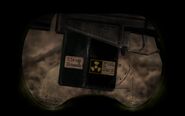| For the artifact also called "batteries", see Battery (artifact). |
Batteries, also known as Accumulators and Gauss rounds, are a special type ammunition exclusively used by the Gauss rifle and the EM1 Rifle featured in S.T.A.L.K.E.R.: Shadow of Chernobyl, S.T.A.L.K.E.R.: Clear Sky and S.T.A.L.K.E.R.: Call of Pripyat.
General Characteristics[]
Gauss rounds have perfect performance in nearly every category - and above perfect notably in piercing and armor penetration, giving it the ability to completely ignore any kind of armor in the series. In fact, Gauss rounds perform better against heavier armor, and along with some sniper rounds is one of the only munitions in the game capable of killing multiple targets with one shot. Also they are able to kill the most dangerous mutants in few shots. They consist of encapsulated pieces of the Flash artifact, which supply the energy required to propel the electromagnetic slugs at extreme velocities.
Compatible Weapons[]
Appearances[]
Shadow of Chernobyl[]
Energy cells prepared with lethal elements in a Gauss rifle magazine. The energy source is an encapsulated piece of the Flash artifact.
― In-game description
Known as Gauss rounds, these can be only salvaged from Monolith snipers using Gauss guns within Pripyat, the Chernobyl Nuclear Power Plant, the Sarcophagus and the Monolith Control Center. Up to 10 can be found by looting a sniper, and there will be usually a few loaded into the weapon. This allows one to collect as much as 100 rounds, although not all snipers in Pripyat will fall in the accessible area, and some snipers at the NPP are not accessible.
Clear Sky[]
High-capacity energy cells. Used to power a prototype of the EM1 electromagnetic rifle.
― In-game description
Gauss rounds return as Accumulators, and are used by the EM1 Rifle. They are necessary at the end of the game in order to disable Strelok's psi-protection. Ten accumulator batteries can be found in the Army Warehouses as part of a side quest; they are located inside a locker near a crashed helicopter surrounded by a psi-field and six Monolith veterans (all armed with SA Avalanches), and must be returned to a mercenary or a Loner squad leader for a few thousand rubles. At the end of the game, the EM1 Rifle that is given to Scar is loaded with 100 accumulator batteries, and no spares are given.
Call of Pripyat[]
Batteries that use a capsulated fragment of the Flash artifact as their power source. Manufactured using hi-tech equipment.
― In-game description
The ammunition is named Batteries in Call of Pripyat, and is found in finite quantities in the game. It has even better penetration than its previous iterations. No more than 15 batteries can be found in the game, the locations being:
- A total of nine batteries can be found in the Monolith stashes.
- One is loaded in the Gauss rifle when acquired from the Preacher.
- One can be acquired if the player unloads the Gauss rifle before giving it to Cardan for repairs. When Cardan hands the weapon back, it will come with a loaded battery.
- Two are found in the room containing the Calibration tools in the Old Service Center in Pripyat.
- Finally, the last two can be acquired by giving Strelok the three notes from his group's stashes. In order for him to give the batteries, the player must have the weapon in their inventory, otherwise he'll give three Scientific medkits instead.
The game also introduces a new variant of Batteries known as Homemade batteries. The only difference is the weight, as the Homemade batteries weigh 0.5 kg per 6 rounds unlike 0.5kg per 10 rounds for the originals. It can also be purchased in infinite quantities.
Gallery[]
Trivia[]
- In all games, "9mm" can be seen written on a tag on the ammunition's model, but in Call of Pripyat the tag on the Gauss rifle's magazine reads 2.54mm instead.
| |||||||||||||||||||||||||||||||||||

